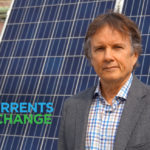Kristina Groves

Olympic speed skater | Bullfrog Power green champion
A four-time Olympic medalist, Kristina Groves is one of Canada’s most respected and accomplished athletes. Groves won two silver medals at the 2006 Winter Olympics in Turin, Italy, and went on to qualify for five speed skating events at the 2010 Winter Olympics in Vancouver. In Vancouver, she took home the silver medal in the 1500m and the bronze in the 3000m.
Of all Canadian speed skaters, Groves is tied for the highest medal count (13) in the World Single Distances Championships. She won three overall World Cup titles in the 1500m and is a former world record holder, with her teammates Christine Nesbitt and Brittany Schussler, in the Team Pursuit; their team set the world record in 2009.
Groves retired from speed skating in 2011 and returned to school, earning her master’s degree in Sustainable Energy Development in 2015. She currently works as a consultant in the renewable energy industry in Alberta, focusing mainly on utility-scale solar projects. She is also the Project Ambassador and a Board member for the Alberta Solar Co-op, an organization working to build the first cooperatively owned solar farm in Alberta. Since retiring from sport Kristina also built an energy efficient home with her partner Scott that features PV and solar thermal systems and many other energy efficient features. They have two young daughters.
Bullfrog Power recently caught up with Groves to chat with her on the topics of speed skating, the Olympics and her work in renewable energy.
How did you first develop an interest in speed skating?
It was the 1988 Winter Olympics in Calgary that originally piqued my interest in the sport. I remember being glued to the television watching Canadian skater Gaétan Boucher’s race. There was something about Gaétan in particular and the sport in general that made me want to try it. The inspiration lasted long enough for me to join the speed skating club in Ottawa that fall.
What was your biggest challenge when it came to racing?
I loved the challenge of trying to get better and figuring out how to create the focus and mindset I needed to have the best race on any given day. It took me so many years to figure out that I could create this environment or feeling for myself. At the highest level everyone is incredibly fit and technically strong but what sets a winning performance apart is a skater’s ability to mentally prepare to optimize his or her performance during that race. During the last few years of my career, the challenge for me was learning how to make that happen.
How was competing in the Vancouver Olympics different from other races?
It was different for a number of reasons. First, having the opportunity to compete at a home Olympics is such a wonderful gift for an athlete. It is so rare to have the opportunity to compete at the Olympics in your home country and that makes it pretty special.
At the same time, athletes from the host country are typically under the microscope much more during a home Olympics than they would be otherwise. For me personally, because of the point I was at in my career—I had already competed at the Olympics in Salt Lake City and Turin—there were a lot of expectations and high hopes riding on my performance. This led to an increase in external pressure for me, which was new and challenging.
The other component that is different is that crazy and unusual things are known to happen at the Olympics. That’s partly why they are so fun and engaging; the competition is completely unpredictable. For example, it was anticipated we would win the gold medal in the Team Pursuit in Vancouver and we didn’t even make it past the first round. It was absolutely devastating. Also, I wasn’t expected to place in the 3000m and I took bronze, which was really exciting.
At the end, how did it feel to take home two medals?
I was thrilled I won two medals and was able to contribute to the success of the Games for Canada. I experienced every possible emotion in my races throughout the Games, having finished second, third, fourth, fifth and sixth. Racing at the Games was a very human experience that I could never have totally prepared for and it had a profound effect on my life. I learned a lot about myself and my racing, but I learned a lot about Canada too; how wonderful the Canadian spirit really is.
How did you first develop an interest in the environment and protecting it?
From a very young age, I developed a great care and concern for the environment, and it became a big part of who I am and the choices I make. Growing up, our family vacations usually involved camping, hiking or canoeing trips. I learned early on to value the natural and fragile beauty that surrounds us. My Dad was an engineer and he installed a solar hot water system on our roof over 30 years ago, before systems like these were common or considered necessary. I think I learned a lot from him about making choices that actually have an impact. Also, growing up as an athlete, air quality and the state of the environment were—and continue to be—of utmost importance to me.
I have also learned how profoundly inspiration, either from the things we see, do or read about, can affect our attitudes. If the inspiration is strong enough, we will act on it and make changes in our lives. One common theme that has continually inspired me over the years is environmental protection and sustainability.
What is your perspective on climate change and air pollution?
I am very concerned about climate change and the impact our lifestyle is having on the planet. At first as an athlete, but now as a parent and active member of the renewable energy industry, I am more and more aware of how climate change is affecting the planet as a whole, and our day-to-day existence. This was one of the main reasons we wanted to build the house we did, which generates almost as much energy as we use. Also, I do a lot of cycling, on my own and with my girls, around Calgary, and these days when I ride around town I can see a cloud of smog over the downtown core that I didn’t see 20 years ago. I am deeply concerned that I breathe in this pollution every day, and that it could be having an impact on my health.
Where did you hear about Bullfrog Power and why did you decide to sign on?
I learned about Bullfrog Power from one of my teammates and from bullfrogpowered stickers on some of the local businesses here in Calgary. I chose to sign on because I want to take personal responsibility for the impact I’m having on the planet—both at home and in my career. I’m ok with paying a little more for green electricity because I know it is coming from clean sources. It really is a nominal cost, and if enough people sign up we can make a huge difference.
What other things have you done in your personal life to reduce your environmental footprint and promote sustainability?
We hang all of our clothes to dry and use a front load washing machine. All of the water fixtures in our house are low-flow (our family of four uses less than ¼ the average water consumption per four/person household in Calgary). Our house is near-net-zero and is all-electric, so we are almost carbon-neutral as well. With regard to transportation, we bike as much as possible and aim to choose activities that are nearby instead of driving across town.
As a parent I also try to teach my kids about energy and water consumption and explain to them why we should conserve. They are only 4 and 6 but they help me hang the laundry and understand how the solar panels power our home!
If you had one message for all Canadians about taking action on the environment, what would that message be?
It’s hard for a lot of people to connect the small actions they take every day to this larger problem of climate change. However, I believe we can make a difference and that by working together, we will turn the tides. I encourage people to first be mindful and think about the impact their behaviour is having on the planet. Then, take small, simple steps to conserve, minimize what you do use, and find greener ways of doing things where you can. Like most things, it will get easier as you go.
About green champions
Thousands of people bullfrogpower their homes with green electricity, green natural gas, or both. Together, these green champions are shrinking their carbon footprints, transitioning our energy systems to clean sources, and showing others that the future is renewable.
Explore other green champions profiles:
Marc Yamaguchi
Kirby Wirchenko
Mike Brigham
Join the 20,000 subscribers who care about the future of renewable energy
Sign up for the eBuzz, our newsletter featuring green energy updates, new product information, and stories from the community projects we support.


